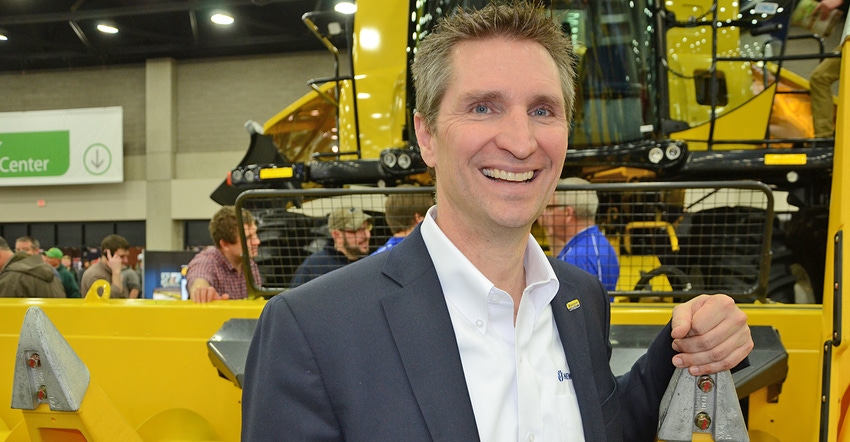April 11, 2018

Leading a U.S. farm equipment firm isn’t for the faint of heart these days. Until recently, softer commodity prices have crimped demand for new iron, and that makes planning and investing for the future a challenge, too. Yet New Holland is pushing ahead with new technology investments, including its autonomous tools — and Bret Lieberman is leading the way.
Lieberman is vice president, New Holland North America, and he’s leading the division that’s bringing autonomy to the ag market in new ways. And when Lieberman talks about these new tools, he starts with the here and now. “As you see, we’re promoting IntelliBale and IntelliCruise to our core customer in the hay market,” he says. “We are leading the industry in those areas.”
The tech there is ISOBUS-based, and in fact has the baler driving the tractor. This enhances efficiency when baling large round or large square bales. For example, with IntelliBale, the system will stop the tractor automatically to wrap and release the bale, ending the need for constant bale monitoring during that chore. Note: The operator still controls when the tractor moves forward.
New Holland is part of CNH Industrial, which also owns the Case IH brand, but each of these brands is engaging tech in its own way. New Holland is focusing on its core markets, where automation and advanced tech can make a difference. That includes an autonomous tractor project in California working with the E. & J. Gallo Winery.
“We announced that NH Drive technology will be put into the field in a test with Gallo — we have a relationship with Gallo for that,” Lieberman says. “This will be in a real application with a specialty tractor, and we are keying in on some of our New Holland customers.”
The tractor — a T4.110F — will be put to work in a pilot program for vineyard tractors, which Lieberman noted is a confined space that offers the chance to test the machine in a number of circumstances. “As you know, you don’t roll out of bed and flip the switch on this technology; but with the relationships we have, we can work with them in that environment. We’re working to take the autonomy to the next level,” he says.
Retrofit for autonomy
When New Holland first launched its autonomy tech at the Farm Progress Show in 2016, the company took a different approach from its red counterpart. NH Drive has the potential to be a retrofit to existing tractors; however, Lieberman is quick to note that this is much more complicated than it first appears.
“There are a range of technologies out there, and different machines are at different levels,” he explains. “We want to be able to work toward solutions for our customers, and when the tech doesn’t match up for the customer not in a market for a new tractor, we want to be adaptable.”
Not every tractor can be made autonomous in the aftermarket. However, as companies look at tech capabilities and as new tractors add ISOBUS capabilities, more is possible. When asked if someday a tractor may come with a badge that says “autonomous ready,” Lieberman notes, “That would be possible, but it’s not an easy question to answer until you get into the guts of the machine and understand how you can control the subsystems of the unit.”
That’s even true now with IntelliBale and IntelliCruise technology. Not every New Holland tractor has the capability to use these efficiency tools, but newer machines are getting that tech.
Markets and tech
Talking with the vice president of a machinery division always brings questions about the current state of the economy. It’s been soft for four years now, but Lieberman notes that he’s seeing some positive signs. “I would say we’re cautiously optimistic as we look at the hay industry in the last three months,” he says. “In the last quarter and in January, we’re seeing improved numbers year over year that we have not seen in a long time, which is an indicator for us.”
The company hasn’t waited for a market turnaround to invest in technology, expand partnerships and work on new tools for farmers, which he sees as necessary for the future. “We’re investing more in technology — that’s just the plain fact of our corporate strategy,” he says. “With the inputs farmers use, the nutrients and the rise of precision agriculture, farming is one big science project, and we know the tech side of the equipment is going to have to be there to meet those needs.”
About the Author(s)
You May Also Like






